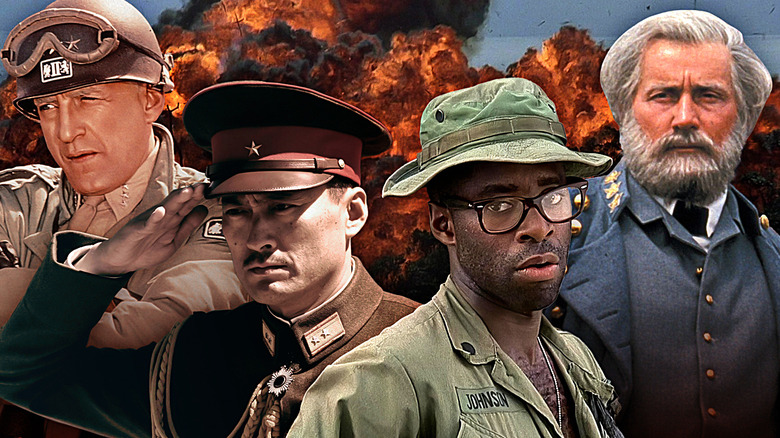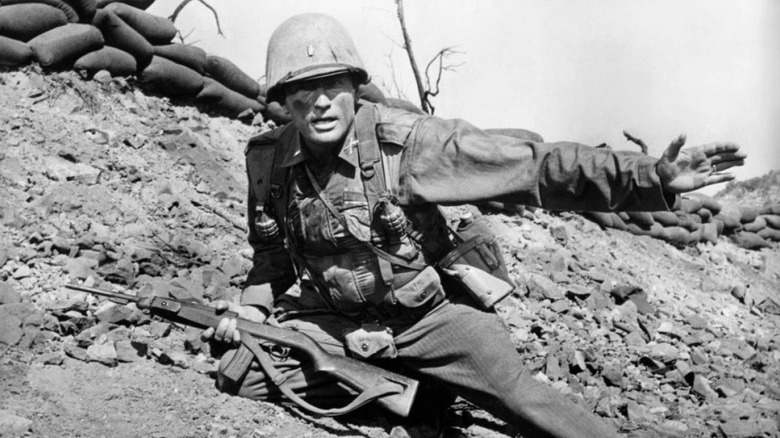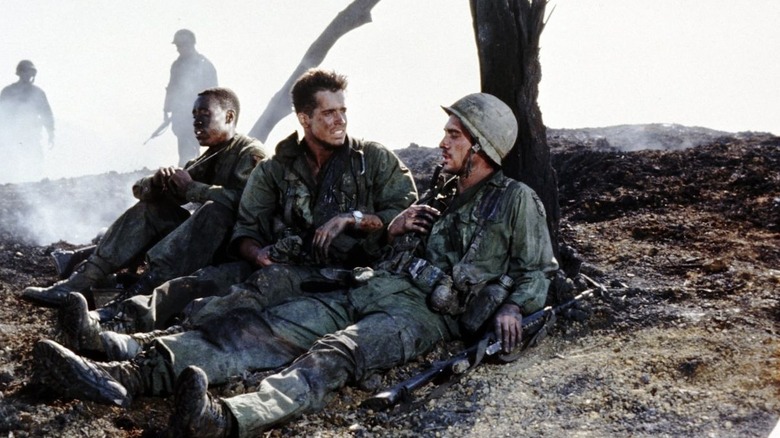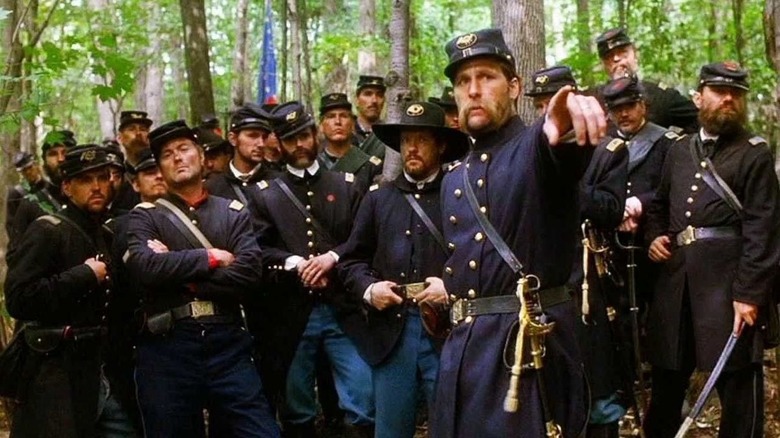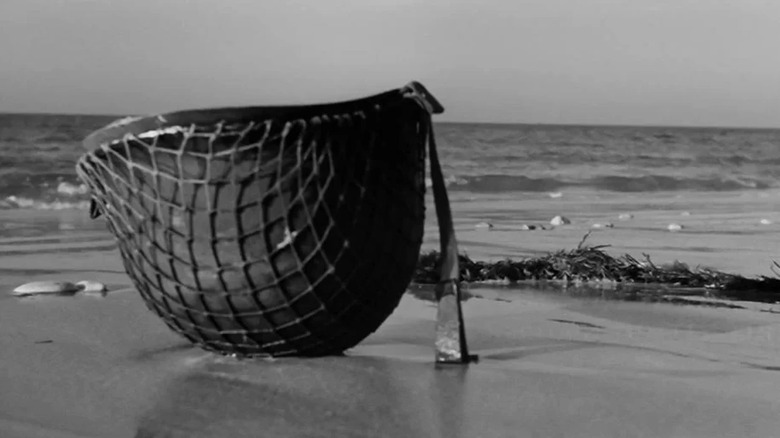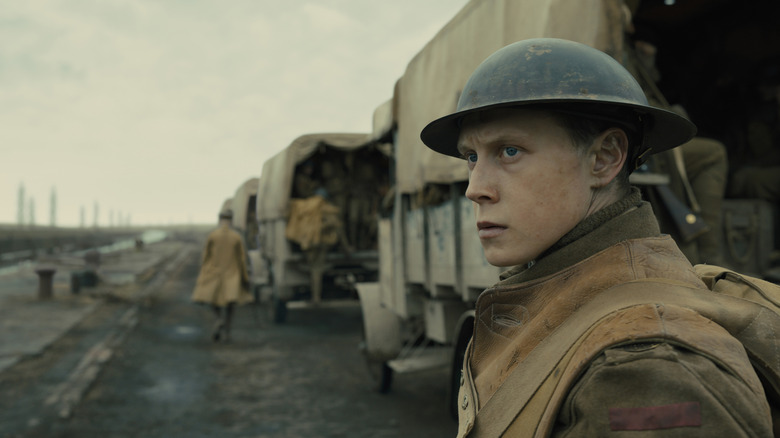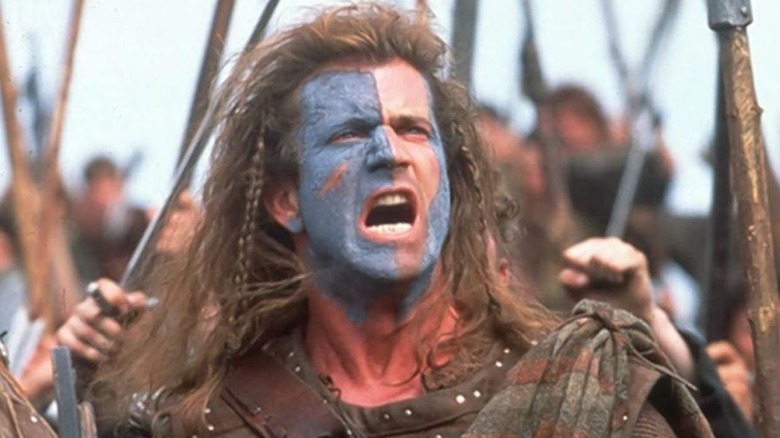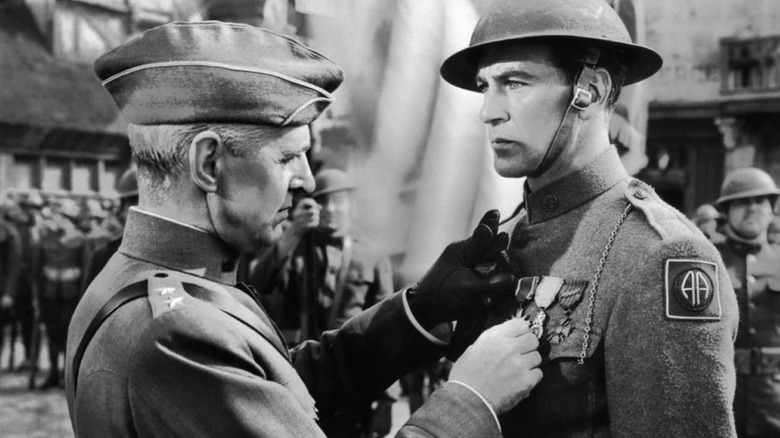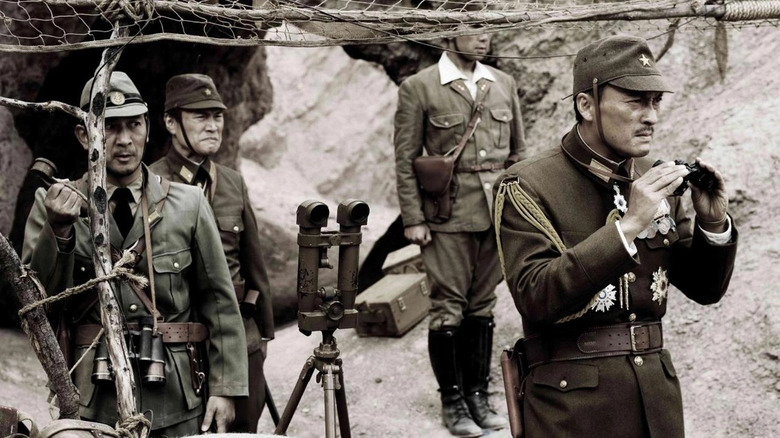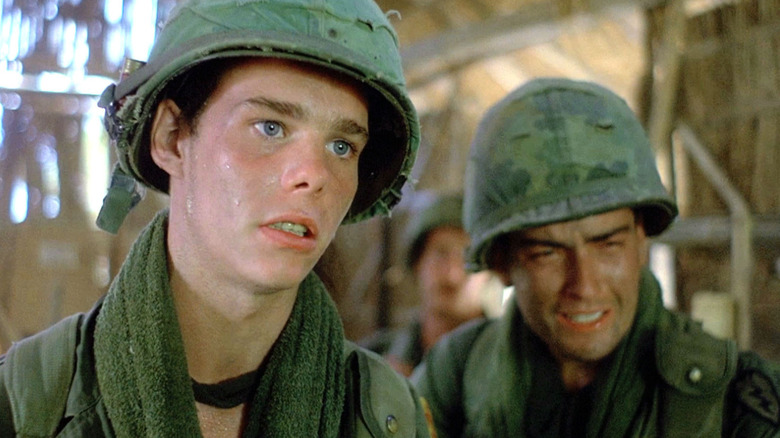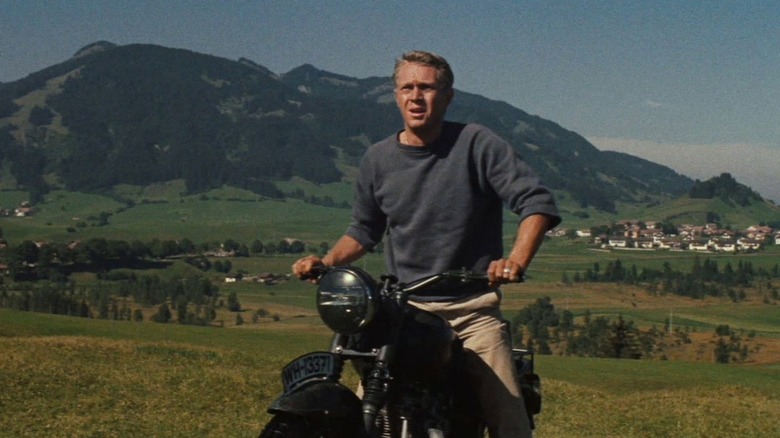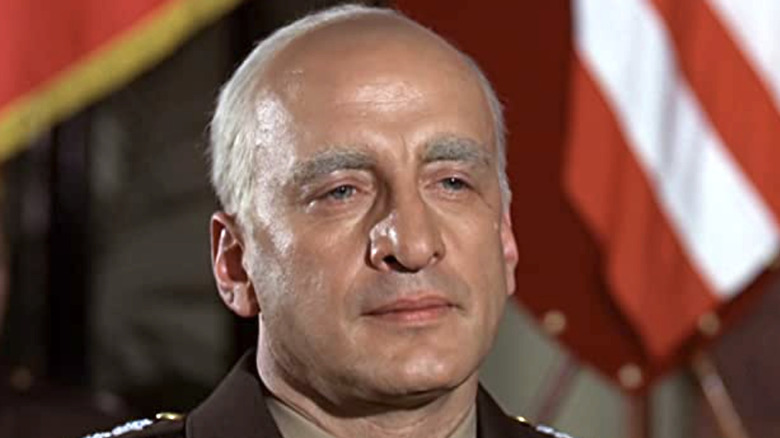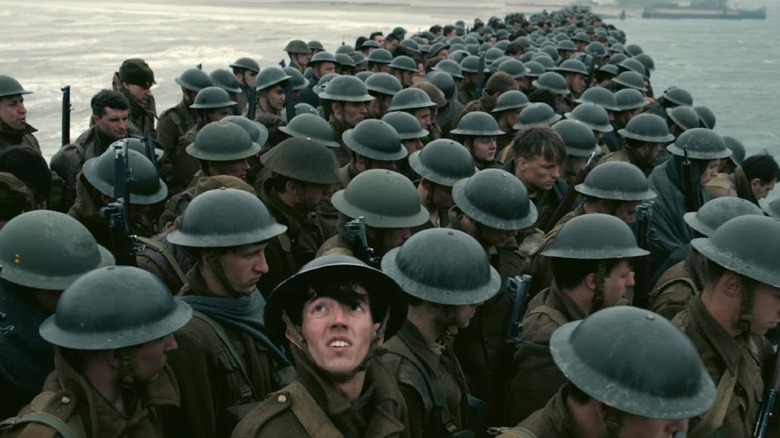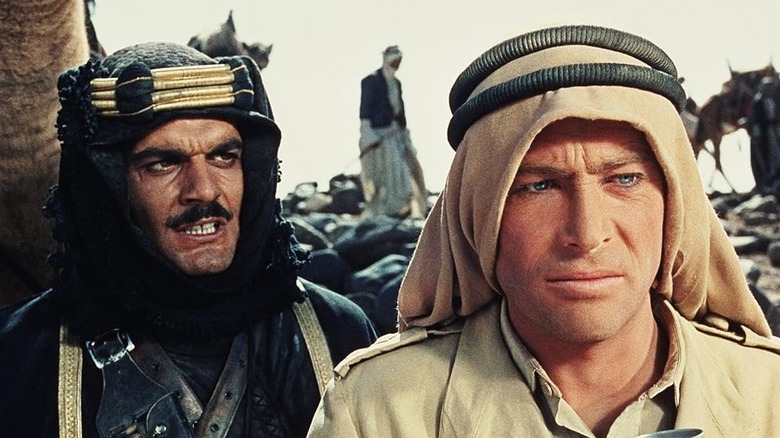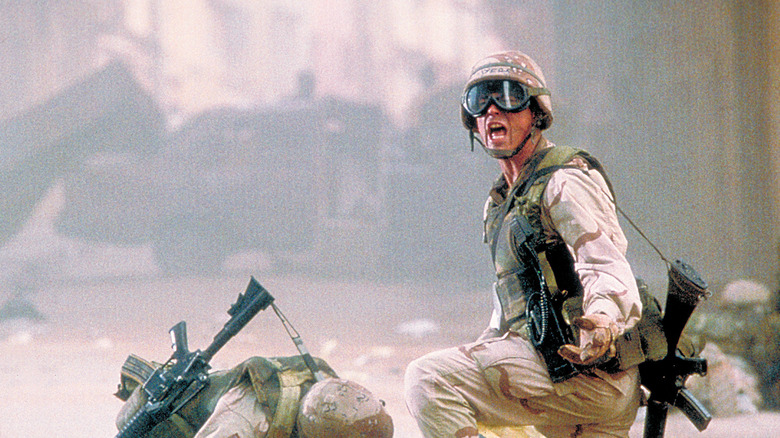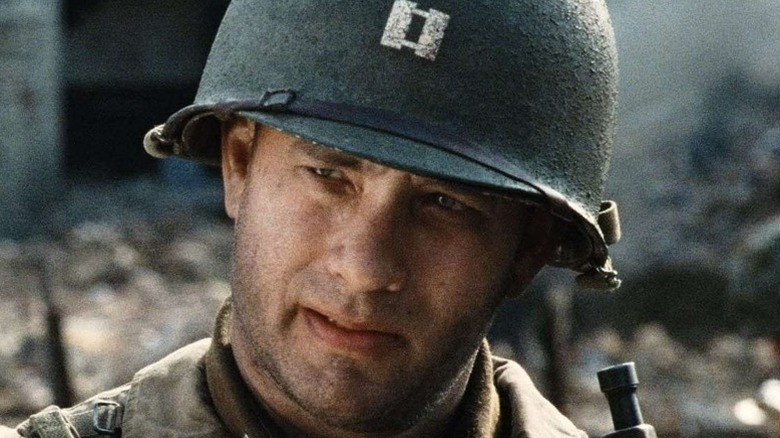The 15 Best War Movies Based On True Stories
Hollywood is full of war movies filled with the gallantry and fiery combat viewers have come to expect with the genre across numerous conflicts throughout history. However, not as many of these films are based on true stories as one might expect, instead taking a historical battle and fabricating a story around it. Whenever a war movie has a real-world basis inspiring it, there is a greater emotional weight in knowing that some version of these events were experienced by actual people. That isn't to say that every war movie based on true stories is necessarily historically accurate, but the heightened verisimilitude still elevates the narrative.
Beyond direct adaptations of historical events and accounts, there are also many war movies inspired by anecdotes from incidents in actual armed conflicts. Though the stories derived from these experiences are largely fictional, there's enough of a real-world basis that grounds the movies in history and genuine emotion. Here are the 15 best war movies based on true stories, either directly depicting historical events or strongly inspired by them.
Pork Chop Hill
The final year of the Korean War had the American and Chinese armies regularly gaining and losing territory during peace talks. One particularly hard-fought region, nicknamed Pork Chop Hill because of its shape, took place at an outpost just over the North Korean border. The first major battle of Pork Chop Hill in April 1953 is the subject of 1959's "Pork Chop Hill," adapting S.L.A. Marshall's 1956 historical novel. As Lieutenant Joe Clemons (Gregory Peck) and his unit defends the outpost, they realize the skirmish is part of a larger test of American mettle by the Chinese.
While "Pork Chop Hill" may seem like a conventional '50s war movie, it has a more cynical edge and commentary on the futility of war than its contemporaries. Peck is given one of his grimmest and world-weariest roles in his career. "Pork Chop Hill" is also a rare Hollywood examination of the Korean War, a conflict overshadowed in American media by the preceding World War II and subsequent Vietnam War. Joined by an ensemble of solid character actors, Peck elevates "Pork Chop Hill" into a rousing look at one of the Korean War's bloodiest battles.
Hamburger Hill
While movies like "Apocalypse Now" show a more expansive perspective on the Vietnam War, 1987's "Hamburger Hill" offers a much more focused look at the conflict. The movie depicts the May 1969 U.S. Army attack on Hamburger Hill, a Northern Vietnamese stronghold near Laos. The movie follows a group of new recruits as they join a platoon that takes part in the assault to capture Hamburger Hill. By the battle's conclusion, the surviving recruits have been irrevocably changed by the nightmarish fighting as they acclimate to life in Vietnam.
Many young actors got their start with "Hamburger Hill," including Don Cheadle, Dylan McDermott, and Courtney B. Vance. The movie features some of the most vicious battle sequences from a Vietnam War film at that time, maintaining a constant intensity for much of its runtime. Outside of a closing on-screen poem, there are no big speeches or monologues, just men hardened by the fires of combat, trading innocence for survival. "Hamburger Hill" leaves it all on the battlefield with an unrelenting ferocity that will leave viewers as shaken as its characters.
Gettysburg (1993)
The Pulitzer Prize-winning 1974 historical novel "The Killer Angels," by Michael Shaara, was adapted into the 1993 Civil War movie "Gettysburg." Like the novel, "Gettysburg" depicts the three-day long battle between the Union and the Confederacy in Gettysburg, Pennsylvania, in July 1863. For the Union, the primary perspective is from Colonel Joshua Chamberlain (Jeff Daniels), while the main Confederate character is General James Longstreet (Tom Berenger). The movie covers the battle's major moments, ending with Pickett's Charge, breaking the Confederate advance and foreshadowing its eventual defeat.
"Gettysburg" is a no-frills Civil War movie, featuring a solid ensemble cast and grounded battle sequences. Daniels and Berenger provide the biggest standout performances, from Daniels' inspiring speeches as Chamberlain to Berenger's understated portrayal of a leader trying to mitigate a disaster facing his army. Adding to the authenticity of the movie, "Gettysburg" was filmed at the actual battle's location, with thousands of Civil War reenactors participating in the production. One of the best American Civil War movies ever made, "Gettysburg" is a subtle and balanced look at one of the most pivotal battles in the country's history.
The Longest Day
The Allied invasion of Normandy, France, during World War II is the subject of 1962's "The Longest Day," adapting the 1959 non-fiction book by Cornelius Ryan. The movie is told from a multitude of perspectives in the joint operation, culminating in a full-scale invasion from sea and air. Stories throughout the nearly three-hour film include the French Resistance, the German command in occupied France, American paratroopers descending behind enemy lines, and the Allied soldiers landing on Normandy's beaches. Filling out the expansive cast are all-star ensembles from the U.S., the United Kingdom, France, and Germany, many portraying real-life historical figures.
"The Longest Day" is an old-fashioned holiday epic, boasting a cast of hundreds filmed around France, including at several locations depicted in the movie. The movie became the most expensive black-and-white film ever made, without adjusting for inflation, until 1993's "Schindler's List." The movie's smaller-scale stories work better than the bombastic battles, with the paratroopers' grueling experience the night before D-Day as the biggest highlight. A true epic depicting how D-Day unfolded to the hour, "The Longest Day" is an unabashedly grandiose look at WWII's biggest invasion.
1917 (2019)
Inspired by tales of his grandfather's World War I service, filmmaker Sam Mendes created the riveting war movie "1917" in 2019. Just as Mendes' grandfather was a courier during the war, "1917" follows two messengers tasked with delivering a message about a planned German trap for advancing British forces. This leads to a deadly odyssey across no man's land, abandoned German trenches, and a bombed-out French village to deliver their message in time. To maintain this sense of urgency, "1917" plays out like two prolonged continuous shots as its protagonist Will Schofield (George MacKay) makes his journey.
Working with cinematographer Roger Deakins, Mendes creates one of the most engaging war movies of all time. From its extended, relatively uninterrupted sequences to its evocative and atmospherically lit set design, "1917" is a visual and technical marvel. Through Schofield's eyes, audiences are given a tour of the WWI experience on the ground, as he trudges through wartime hell. One of the most ambitious war movies, "1917" is the film that holds its viewers' full attention and never lets go.
Braveheart
The saga of Scottish warrior William Wallace, who led the First Scottish War for Independence in the 13th century, is the subject of 1995's "Braveheart." In addition to producing and writing the movie, Mel Gibson stars as Wallace, who rises against King Edward I (Patrick McGoohan) after losing his wife to English oppressors. Wallace's resulting rebellion inspires Scotland to rally and reject their English rulers, leading to a bloody war. Even in the face of the overwhelming English army and threat of torturous execution, Wallace refuses to dismiss his crusade to restore Scottish freedom.
While not necessarily the most historically accurate movie, "Braveheart" exudes the defiant spirit of Wallace and his contemporaries. Boasting battle scenes with hundreds of extras from the Irish Army, Gibson keeps the action easy to follow and rooted on the story's main characters. "Braveheart" succeeds not so much as a history lesson, but as a swashbuckling epic and medieval romance. Arguably the most well-rounded and effectively helmed project in Gibson's directorial career, "Braveheart" remains one of the best medieval war movies ever made.
Sergeant York
One of the most decorated American soldiers who served during World War I was Alvin C. York, a sharpshooter who fought in the pivotal final Allied offensive of the war. York's diary serves as the basis for 1941's "Sergeant York," starring Gary Cooper as York. The movie traces York's humble beginnings in Tennessee and his inner turmoil between serving his country or abstaining due to his religious convictions. Joining the U.S. Army, York single-handedly ambushes a major German position during the Meuse-Argonne offensive, becoming a war hero.
"Sergeant York" provides Cooper with the archetype he found the most success in, an everyman who steps up and makes a difference in the face of extraordinary circumstances. The real-life York had resisted numerous efforts to adapt his story to the big screen, relenting on the condition that Cooper play him. Cooper more than does the role justice, and "Sergeant York" excels when it focuses on York's inner conflict rather than the exploits he became known for. Cooper's sole competitive Academy Award win was for "Sergeant York," while the movie became highest-earning in 1941, connecting with audiences as America's entry into another world war loomed ahead.
Letters from Iwo Jima
In 2006, filmmaker Clint Eastwood released a pair of World War II movies offering opposing perspectives in the war's Battle of Iwo Jima. The better of the two is "Letters from Iwo Jima." As the Japanese steadily lose ground on Iwo Jima to advancing American forces, Saigo (Kazunari Ninomiya), debates whether he should surrender, commit honorable suicide, or keep fighting. This internal struggle is explored as Saigo continues to retreat deeper into Iwo Jima, meeting other Japanese soldiers coming to terms with imminent defeat.
Though the protagonist, Saigo, is largely fictional, "Letters of Iwo Jima" draws heavily from two historical non-fiction books on the battle: "So Sad to Fall in Battle" by Kumiko Kakehashi and "Picture Letters from Command-in-Chief" by General Tadamichi Kuribayashi, with the latter played in the movie by Ken Watanabe. "Letters of Iwo Jima" is an all-around improvement over "Flags of Our Fathers," boasting a more compelling human story at its core, along with more impressive cinematography and combat sequences. A focused and rare Hollywood look at the Japanese experience during WWII, "Letters of Iwo Jima" is another Eastwood masterpiece and arguably the best war movie he ever directed.
Platoon
Filmmaker Oliver Stone served with the U.S. Army during the Vietnam War, seeing combat and being wounded in action twice during his service. His wartime experiences served as the basis for his 1986 film "Platoon," which he wrote and directed, seeking to create a more realistic depiction of the war. The movie follows Chris Taylor (Charlie Sheen), a young infantryman stationed near the Vietnamese-Cambodian border, where they are under constant attack from Northern Vietnamese troops. Taylor also has to contend with his sadistic superior Staff Sergeant Barnes (Tom Berenger), who murderously harrasses local villagers and his own men.
Compared to the overtly jingoistic "The Green Berets" or the surreal "Apocalypse Now," "Platoon" is an unflinchingly realistic portrayal of life on the Vietnam War's front lines. "Platoon" provides an overwhelming viewing experience, with its constant barrage of on-screen violence and casual cruelty. Berenger delivers the most villainous performance of his career, countering Sheen and Willem Dafoe's more heroic roles. One of the most personal movies Stone ever directed, "Platoon" is still one of his best and one of the greatest cinematic depictions of the Vietnam War.
The Great Escape
In 1944, over 70 Allied prisoners of war escaped from a German camp, with three making it to freedom while 50 of the escapees were captured and executed. This served as the basis for the 1950 non-fiction book "The Great Escape" by Paul Brickhill, which was adapted into a movie of the same name in 1963. The movie takes some liberties, adding American prisoners to the camp, including Steve McQueen as American pilot Virgil Hilts.
Aside from its American inclusion, "The Great Escape" keeps the broader strokes of the historical event relatively accurate for the movie. The idea of the prisoners developing an ingenious scheme of building three tunnels outside of the camp and trying to blend in with the local populace are spot-on. McQueen and co-star James Garner are charismatic standouts from the ensemble, with both characters lighting up an entire scene considerably whenever they're on-screen. Over 60 years since its initial release, "The Great Escape" remains a World War II classic and one of the best war movies of the '60s.
Patton
Firebrand American military leader General George S. Patton is the subject of the 1970 biopic "Patton," with George C. Scott playing the title role. Rallying the U.S. Army after its disastrous initial incursion into Nazi-held North Africa in World War II, Patton battles the Germans across Africa and Europe. However, his volatile personality, disregard for authority, and contempt for his British counterparts jeopardizes his role in the Allied war effort. Despite this, Patton finds success in helping the Allies drive the Axis Powers out of Sicily and counter-attacking a German assault during the Battle of the Bulge.
From its iconic opening sequence of Patton addressing his troops before an American flag to his closing monologue, "Patton" is an all-around triumph in filmmaking. Scott's performance as Patton is, appropriately, the main driving force of the movie and he completely embodies his stern role. "Patton" isn't just a near-perfect war movie, it's also a nearly flawless biopic, one that set the template for them moving forward. "Patton" doesn't seek to explain or deify its protagonist, but rather offer audiences a closer look at a fiery figure who helped win WWII.
Dunkirk (2017)
After spending so much of his career helming superhero and science fiction movies, filmmaker Christopher Nolan shifted to much more grounded subject matter with 2017's "Dunkirk." The movie depicts the British mass evacuation from Dunkirk, France, in the face of a relentless German advance in 1940. The story is split into three narratives from the perspectives of a soldier on the French beach, a ship ferrying Allied troops to Britain, and a pilot defending the convoy. As the Germans escalate their attacks on the besieged Allies, these perspectives begin to cross paths during the evacuation.
"Dunkirk" is the shortest movie directed by Nolan to date, and, arguably, the most ambitious project he's taken on. Across its multiple perspectives, Nolan maintains a mounting sense of tension and dread as the British troops try to survive and evade the enemy, who largely remain clearly unseen. That suspense and urgent pacing makes "Dunkirk" crackle with an energy unlike any of Nolan's other projects, with the threat of German attack hovering over every second on-screen. Tautly staged and with fantastic performances from its lead actors, "Dunkirk" is Nolan at his leanest and meanest as a filmmaker.
Lawrence of Arabia
Perhaps the most quixotic figure in the British military in the early 20th century is T.E. Lawrence, who coordinated attacks on the Ottoman Empire during World War I. Lawrence's 1926 wartime memoir "Seven Pillars of Wisdom" inspired 1962's "Lawrence of Arabia," starring Peter O'Toole as Lawrence. As Lawrence becomes enamored by Arabian culture, he grows increasingly reckless in battle and openly disregards his orders in dealing with local leaders and how to battle the enemy. This mounting obsession chafes with Lawrence's place in the British military, along with his hopes to develop a unified and independent Arabian state.
"Lawrence of Arabia" truly is a sweeping historical epic in every sense of the term, from its widescreen presentation to its ambitious battle sequences. O'Toole and co-star Omar Sharif both deliver star-making performances, with O'Toole displaying a cool detachment as Lawrence. Filmed throughout Morocco, Jordan, and Spain, "Lawrence of Arabia" features the most haunting cinematography of director David Lean's celebrated career, as he takes advantage of the desert scenery. An absolute masterpiece of classic cinema, "Lawrence of Arabia" revolves around the rise and fall of an enigmatic historical figure at the center of WWI's most forgotten battles.
Black Hawk Down
The 1993 Battle of Mogadishu, which precipitated the American military's withdrawal from Somalia, is the subject of the 1999 non-fiction book "Black Hawk Down" by Mark Bowden. Filmmaker Ridley Scott adapted the book into a movie in 2001, focusing on the American military's failed operation to capture the top lieutenants of local warlord Mohamed Farrah Aidid. After two of the Army's Black Hawk helicopters are shot down in Mogadishu, the mission becomes a rescue operation as the soldiers wait for extraction. The movie follows the perspectives of several different American soldiers while the fighting quickly intensifies.
"Black Hawk Down" is arguably the best war movie of the 21st century and perhaps the best movie Scott has directed since "Blade Runner." The action begins relatively early into the film and rarely lets up, as the American troops are quickly surrounded by Aidid's loyalists. With such a large ensemble cast, Scott masterfully checks in on each of the story's main characters, finding those moments of humanity amid constant battle. Tautly paced and executed, "Black Hawk Down" never feels as long as its runtime or loses sight of its characters' humanity.
Saving Private Ryan
The benchmark against which all modern war movies, especially World War II movies, will be judged, filmmaker Steven Spielberg's "Saving Private Ryan" was an instant masterpiece. Following the Allied invasion of France on D-Day, a squad is tasked with retrieving a lost paratrooper, James Ryan (Matt Damon), after his other brothers are killed in action. This leads to a search behind enemy lines, where the paratroopers are still engaged in bitter fighting against the Nazis.
Historian Stephen E. Ambrose, with screenwriter Robert Rodat, were inspired by the Niland brothers, a family whose four siblings served during the war. After two of the brothers were killed and a third was presumed dead, the fourth was sent home as part of the U.S. Army's Sole Survivor Policy. This served as the narrative basis for "Saving Private Ryan," which subsequently caused a mainstream multimedia resurgence of interest in WWII stories. The movie, a personal project for Spielberg, is the venerable filmmaker's most visceral work and among his most celebrated for its unflinching depiction of men in action during WWII.
